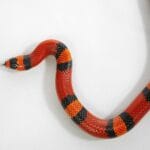Get ready to dive into the amazing world of sharptail snakes! These snakes have a special surprise at the end of their tails, giving them their fun name. They’re not scary at all, and they play an important role in keeping our gardens slug-free. Let’s explore their secret world and uncover all the cool things about these fascinating reptiles.
Unveiling the Mysteries of the Sharptail Snake
Let’s delve into the intriguing world of the sharptail snake, a shy reptile with a knack for hunting and a crucial role in keeping our ecosystems balanced.
Appearance and Identification
Known scientifically as Contia tenuis, these secretive serpents belong to the Colubridae family – a group known for their generally harmless nature, as most species are non-venomous, including the sharptail.
Adults typically reach lengths of 12-18 inches, with their defining characteristic being the sharp, pointed tail tip – the source of their common name. Don’t worry, though; this tail isn’t a weapon against humans. Instead, it likely helps them maneuver and subdue their preferred prey: slugs.
Their coloration provides effective camouflage in their preferred habitats. The dorsal side (back) can range from grayish-brown to brick red, sometimes tinged with pink or peach hues. Their ventral side (belly) displays a striking pattern of black and white crossbars.
Geographic Range and Habitat
Sharptail snakes favor moist environments and are found across the western United States, primarily in California, Oregon, and Washington. Their range extends into Canada, where they inhabit parts of British Columbia, including Southern Vancouver Island, Victoria, and even a recently discovered site in Pemberton.
These snakes are often found lurking beneath rocks, logs, and leaf litter – ideal microhabitats for their favorite food source: slugs. Interestingly, they’ve demonstrated an ability to persist in urban and suburban areas, as long as there’s sufficient cover in the form of gardens, parks, and green spaces.
A Slug’s Worst Nightmare: Diet and Behavior
Sharptail snakes are specialized predators, with a diet that consists almost exclusively of slugs and slug eggs. This dietary preference makes them valuable allies for gardeners, as they act as natural pest control agents. They’ve developed a keen sense of smell, probably aided by chemoreceptors, that allows them to locate and track slugs with remarkable efficiency.
While slugs make up the bulk of their diet, they may occasionally consume insects or earthworms if the opportunity arises.
These snakes are primarily nocturnal, meaning they are most active at night. Their secretive nature makes them a rare sight, even in areas where they are relatively common.
Reproduction and Life Cycle
As the summer months arrive, female sharptail snakes lay a clutch of 4-16 eggs. They seek out secure nesting sites, often underground burrows or cavities beneath logs and rocks.
Upon hatching, the young snakes, measuring a mere 3-4 inches long, are miniature versions of the adults and are equipped to begin hunting slugs on their own.
Conservation Status and Threats
The sharptail snake is currently classified as a species of Least Concern, indicating that their populations are relatively stable. However, as with many reptile species, habitat loss and fragmentation pose ongoing threats.
The recent discovery of sharptail snakes in Pemberton, British Columbia, highlights the importance of continued research and monitoring to better understand their distribution, population trends, and the factors that may impact their long-term survival. Citizen science initiatives, such as iNaturalist, encourage the public to report sightings of sharptail snakes and other wildlife, providing valuable data to researchers and conservationists.
Size Matters: Just How Big Do Sharptail Snakes Get?
Despite their somewhat intimidating name, sharptail snakes are relatively small. Fully grown adults typically measure between 12 to 18 inches long – about the length of a standard ruler or slightly longer. Remember that this measurement includes their tail, which can account for a significant portion of their total length.
Hatchlings, on the other hand, are incredibly tiny, measuring only 3 to 4 inches long. It’s fascinating how these miniature snakes are already equipped to hunt and consume slugs, showcasing the remarkable adaptations of nature.
Unraveling the Secrets of Their Specialized Diet
The sharptail snake’s diet, while seemingly limited, is a testament to their evolutionary success in carving out a unique ecological niche. By specializing in consuming slugs and slug eggs, they’ve tapped into a plentiful food source that other predators often overlook.
Their specialized diet plays a crucial role in maintaining the delicate balance of their ecosystem. Slugs, while important decomposers, can become agricultural pests if their populations go unchecked. Sharptail snakes, by keeping slug numbers in balance, contribute to the health of the ecosystems they inhabit, which in turn benefits humans.
Discover the fascinating dietary habits of other unique creatures:
- Did you know that the shoebill stork includes crocodiles in its diet?
- Immerse yourself in the unique sound of the shoebill stork, a bird with unforgettable calls.
- Unlock Elemental 2 Secrets: Actionable Insights Now - April 2, 2025
- Lot’s Wife’s Name: Unveiling the Mystery of Sodom’s Fall - April 2, 2025
- Photocell Sensors: A Complete Guide for Selection and Implementation - April 2, 2025
















